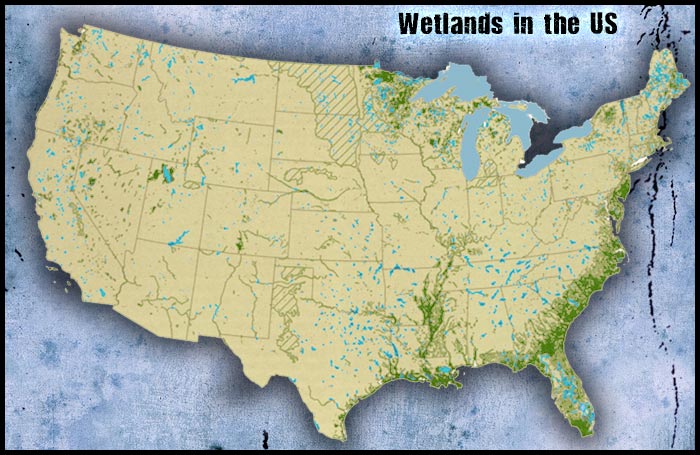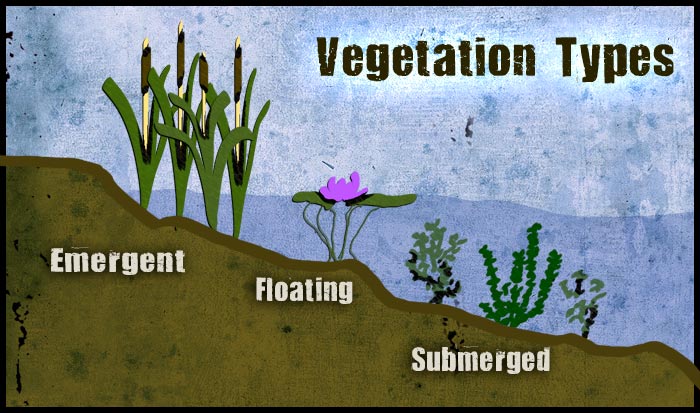Wetlands Biome
What is a Wetland?
A Wetland is described by the plant species that live in it. If an area is wet enough for long enough to support a majority of plants that are adapted to wet conditions then you have a wetland. An example might be a patch of land that is dominated by cattails. Since cattails are adapted to a life where they are partially submerged by water, then the area would be considered a wetland, even if it is dry for a part of the year. Not all wetlands are restricted to freshwater habitats either. Many saltwater marshes thrive in the salty coastal zones.
Types of Wetlands
There are many types of wetlands. Scientists often divide them up into the following groups.
- Marshes
- Swamps
- Bogs
- Fens
Marshes are characterized by the presence of soft-stemmed vegetation adapted to saturated soils. These are typically grasses, sedges or rushes. Some common ones include prairie potholes, the expanses of the Everglades, and salt marshes.
Swamps are characterized by the domination of woody plants. There are many different kinds of swamps including the cypress swamps of Louisiana, Red Maple swamps in the Northeast and the Mangrove forests of tropical and subtropical regions.
Bogs are distinctive wetlands that are low in nutrients and often contain very acidic water and extensive peat deposits. Bogs are also one of the stages of succession as a lake fills in.
Fens are different from bogs in that they receive their water supply from either runoff or groundwater (not rainfall). This usually results in a different water chemistry. Fens have either neutral or alkaline waters and are typically not stages in lake succession.
Where are Wetlands Found?
Wetlands are found all over the world, within almost every terrestrial biome from deserts to alpine tundra. The map below shows the distribution of wetland areas in the United States. Notice the abundance of wetland areas in the Southeast, the Mississippi river system and in the northern states of Minnesota and Wisconsin.
Plants in a Wetland
Plants that are adapted to moist and humid conditions (such as those found in wetlands) are called hydrophytes. These include cattails, water lilies, bulltongue, sedges, tamarisk, and many kinds of rush.
Wetland plants are adapted to the saturated conditions that persist for a majority of the year. The different vegetation types in a wetland can be divided up into emergents, floating, and submerged plants.
An Invasive Wetland Plant: Hydrilla
For the species profile of a wetland plant we decided to pick hydrilla. It is an extremely competitive invader that we have only recently found ways to control. Of particular interest, there is a small fly larvae that eats through hydrilla. We filmed the following episode at the Army Corp of Engineer’s Lewisville, TX, research facility and at their Vicksburg, MS, research facility.
How you can help Save Wetlands
This may or may not come as a surprise, but Wetlands have been reported to be the most threatened ecosystem in the world today. People often see wetlands as wastelands and non-productive land, and these valuable regions are filled in and destroyed. This is endangering human, plant, and animal life at an alarming rate. So what can you do? To help, we’ve found some great links to help you plan your course of action:
- Volunteer your Vacation to Save a Wetland: Earthwatch.org is an organization that actually pairs researchers with volunteers in all kinds of habitats. Go to the webpage and search wetlands. You’ll see all sorts of trips planned. They change all the time so search often.
- Donate $$$ to a Charity: We’ve linked here to the contact page for the Common Sense Environmental Fund that funds research and conservation projects. You give your money to them, and they pick the most qualified conservation initiatives to help fund.
- Join a Wetland Monitoring Group: The Izaak Walton League can help set you up with a local group. Give them a call at 1-800-BUG-IWLA.
- Reduce, Reuse, and Recycle: This is a no-brainer, but we might as well remind you. Everything you can do to reduce your trash will trickle down to less waste in our waterways, including wetlands.
- Be creative, and explore your own wetlands. Find something that you can do like setting up bird shelters, picking up trash, or just monitoring a wetland month to month. You’ll find that you’ll enjoy the time you spend at your wetland, and you’ll want to do everything you can to keep it just like it is.
Related Topics
What is a Wetland?
A Wetland is described by the plant species that live in it. If an area is wet enough for long enough to support a majority of plants that are adapted to wet conditions then you have a wetland. An example might be a patch of land that is dominated by cattails. Since cattails are adapted to a life where they are partially submerged by water, then the area would be considered a wetland, even if it is dry for a part of the year. Not all wetlands are restricted to freshwater habitats either. Many saltwater marshes thrive in the salty coastal zones.
Types of Wetlands
There are many types of wetlands. Scientists often divide them up into the following groups.
- Marshes
- Swamps
- Bogs
- Fens
Marshes are characterized by the presence of soft-stemmed vegetation adapted to saturated soils. These are typically grasses, sedges or rushes. Some common ones include prairie potholes, the expanses of the Everglades, and salt marshes.
Swamps are characterized by the domination of woody plants. There are many different kinds of swamps including the cypress swamps of Louisiana, Red Maple swamps in the Northeast and the Mangrove forests of tropical and subtropical regions.
Bogs are distinctive wetlands that are low in nutrients and often contain very acidic water and extensive peat deposits. Bogs are also one of the stages of succession as a lake fills in.
Fens are different from bogs in that they receive their water supply from either runoff or groundwater (not rainfall). This usually results in a different water chemistry. Fens have either neutral or alkaline waters and are typically not stages in lake succession.
Where are Wetlands Found?
Wetlands are found all over the world, within almost every terrestrial biome from deserts to alpine tundra. The map below shows the distribution of wetland areas in the United States. Notice the abundance of wetland areas in the Southeast, the Mississippi river system and in the northern states of Minnesota and Wisconsin.
Plants in a Wetland
Plants that are adapted to moist and humid conditions (such as those found in wetlands) are called hydrophytes. These include cattails, water lilies, bulltongue, sedges, tamarisk, and many kinds of rush.
Wetland plants are adapted to the saturated conditions that persist for a majority of the year. The different vegetation types in a wetland can be divided up into emergents, floating, and submerged plants.
An Invasive Wetland Plant: Hydrilla
For the species profile of a wetland plant we decided to pick hydrilla. It is an extremely competitive invader that we have only recently found ways to control. Of particular interest, there is a small fly larvae that eats through hydrilla. We filmed the following episode at the Army Corp of Engineer’s Lewisville, TX, research facility and at their Vicksburg, MS, research facility.
How you can help Save Wetlands
This may or may not come as a surprise, but Wetlands have been reported to be the most threatened ecosystem in the world today. People often see wetlands as wastelands and non-productive land, and these valuable regions are filled in and destroyed. This is endangering human, plant, and animal life at an alarming rate. So what can you do? To help, we’ve found some great links to help you plan your course of action:
- Volunteer your Vacation to Save a Wetland: Earthwatch.org is an organization that actually pairs researchers with volunteers in all kinds of habitats. Go to the webpage and search wetlands. You’ll see all sorts of trips planned. They change all the time so search often.
- Donate $$$ to a Charity: We’ve linked here to the contact page for the Common Sense Environmental Fund that funds research and conservation projects. You give your money to them, and they pick the most qualified conservation initiatives to help fund.
- Join a Wetland Monitoring Group: The Izaak Walton League can help set you up with a local group. Give them a call at 1-800-BUG-IWLA.
- Reduce, Reuse, and Recycle: This is a no-brainer, but we might as well remind you. Everything you can do to reduce your trash will trickle down to less waste in our waterways, including wetlands.
- Be creative, and explore your own wetlands. Find something that you can do like setting up bird shelters, picking up trash, or just monitoring a wetland month to month. You’ll find that you’ll enjoy the time you spend at your wetland, and you’ll want to do everything you can to keep it just like it is.


































































































